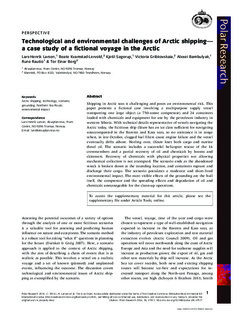| dc.contributor.author | Larsen, Lars Henrik | |
| dc.contributor.author | Kvamstad-Lervold, Beate | |
| dc.contributor.author | Sagerup, Kjetil | |
| dc.contributor.author | Gribkovskaia, Victoria | |
| dc.contributor.author | Bambulyak, Alexei | |
| dc.contributor.author | Rautio, Rune | |
| dc.contributor.author | Berg, Tor Einar | |
| dc.date.accessioned | 2019-02-15T20:42:48Z | |
| dc.date.available | 2019-02-15T20:42:48Z | |
| dc.date.created | 2016-05-30T12:24:05Z | |
| dc.date.issued | 2016-04-26 | |
| dc.identifier.citation | Polar Research. 2016, 35:27977 (2016), 1-12. | nb_NO |
| dc.identifier.issn | 0800-0395 | |
| dc.identifier.uri | http://hdl.handle.net/11250/2585783 | |
| dc.description.abstract | Shipping in Arctic seas is challenging and poses an environmental risk. This paper presents a fictional case involving a multipurpose supply vessel transporting one large object (a 750-tonne compressor) and 24 containers loaded with chemicals and equipment for use by the petroleum industry in western Siberia. With technical details representative of vessels navigating the Arctic today, the fictitious ship Oleum has an ice class sufficient for navigating unaccompanied in the Barents and Kara seas, so no assistance is in range when, in late October, clogged fuel filters cause engine failure and the vessel eventually drifts ashore. Heeling over, Oleum loses both cargo and marine diesel oil. The scenario includes a successful helicopter rescue of the 16 crewmembers and a partial recovery of oil and chemicals by booms and skimmers. Recovery of chemicals with physical properties not allowing mechanical collection is not attempted. The scenario ends as the abandoned wreck is broken down at the stranding location, and containers rupture and discharge their cargo. The scenario postulates a moderate and short-lived environmental impact. The most visible effects of the grounding are the hull itself, the compressor and the spreading effects and degradation of oil and chemicals unmanageable for the clean-up operations. | nb_NO |
| dc.language.iso | eng | nb_NO |
| dc.rights | Navngivelse-Ikkekommersiell 4.0 Internasjonal | * |
| dc.rights.uri | http://creativecommons.org/licenses/by-nc/4.0/deed.no | * |
| dc.title | Technological and environmental challenges of Arctic shipping - a case study of a fictional voyage in the Arctic | nb_NO |
| dc.type | Journal article | nb_NO |
| dc.type | Peer reviewed | nb_NO |
| dc.description.version | publishedVersion | nb_NO |
| dc.rights.holder | © L.-H. Larsen et al. This is an Open Access article distributed under the terms of the Creative Commons Attribution-NonCommercial 4.0 International License (http://creativecommons.org/licenses/by-nc/4.0/), permitting all non-commercial use, distribution, and reproduction in any medium, provided the original work is properly cited | nb_NO |
| dc.source.pagenumber | 1-12 | nb_NO |
| dc.source.volume | 35:27977 | nb_NO |
| dc.source.journal | Polar Research | nb_NO |
| dc.source.issue | 2016 | nb_NO |
| dc.identifier.doi | 10.3402/polar.v35.27977 | |
| dc.identifier.cristin | 1358328 | |
| cristin.unitcode | 7566,7,0,0 | |
| cristin.unitcode | 7566,9,0,0 | |
| cristin.unitname | Energi og transport | |
| cristin.unitname | Skip og havkonstruksjoner | |
| cristin.ispublished | true | |
| cristin.fulltext | original | |
| cristin.qualitycode | 1 | |

